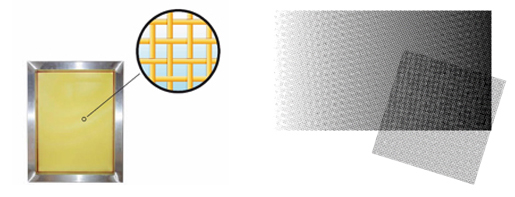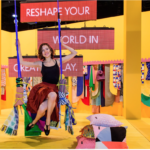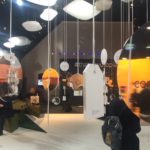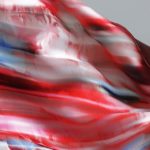A revolution in screen textile printing
Innovative dot screen software, allows to revolutionize the textile screen process overcoming its technological limits to obtain shades without moiré effect.
Rather confusingly for screen process printers, this grid is also called a screen. To make it clear what you’re talking about, it’s best to distinguish the two by calling the printing aspect “screen process” or “screen print” and the dot grid the “dot screen,“ “halftone screen” or “tint screen”.
It is an ongoing project, now in version 4.0 and with many installations, which consists of a complete, professional software RIP designed to work with multiple clients and multiple outputs dedicated to textile screen printing. Called XerioRIP, it allows to control 100 percent size of the dots in order to be always sure that these ‘points’ can be printed in production.
To learn more about this new software system, we turn to Gianpaolo Coin, Grafco – an Italian company active since 1979 in the supply and manufacture of inks, and providing technical support to companies operating in screen printing and textile printing – who followed the birth and developments of XerioRIP.
XerioRIP has been developed in GrafcoAST, a prepress specialised company working closely with the technicians of Grafco. This collaboration has resulted in an in-depth examination of all the key parameters involved in the textile printing to overcome the main technological limit of these printing technologies.
“Few industrial departments – says Gianpaolo Coin – have undergone a deep change as the prepress in printing industry. But this was mainly in the field of offset printing while technologies such as screen printing and textile printing does not seem there are derivatives of the same quality benefits from these technological innovations.”
Why this ?
“It’s hard to say, why this happened, – tells us Coin – but often the craftsmanship of printers and a lack of consideration of the importance of image management, have simply brought prepress operators of screen process and textile printing companies to using “somehow” software and systems developed for offset, without performing a more comprehensive discussion.”
In extreme synthesis – explains Coin – screen printing (but this also applies to the textile printing) has technical limitations related to the fact that the printing is done by pushing the ink through a fabric, and in fact, the screen printing is defined a permeographic printing technique. So, the structure or texture of the fabric in screen printing consists of vertical and horizontal wires which goes to interfere noticeably with the screens dots in four color shades and creating very noticeable moiré problems.

“Another problem is that the screen printing fabric limits the control of the printability of the dots and the very small ones tend to close, and the negative ones tend to disappear for the dot gain on the printed substrate causing a shade “truncated” with loss of definition and lower image quality.”
A new kind of halftone screen
But there is a solution? You mentioned before that screen printers fit and try to come up with all possible ‘tricks’ to print shades or colours, using a halftone screen originally created for offset printing.
“But this is not a solution, because in addition to create printing problems, it is an approach that generates a strong instability in the production quality, with results that vary every few copies during the press. That’s why, following specific requests of several textile and screen printing companies that wanted to get a higher quality, we developed XerioRIP, which is able to generate new types of screen dots to give the best possible quality results.”
Let me see… while the traditional screen pattern creates moiré, the new software designed by GrafcoAST generates a new type of pattern as it uses a new geometry and a completely different algorithm, which allows to increase the quality in gradients in the screen process. Correct?
“XerioRIP 4 is software that allows the textile and screen printing to make a qualitative leap because, for the first time, is presented to the textile screen printing and prepress operators complete control to generate the screen pattern used to reproduce shades of CMYK and esachrome separation.”
But how?
“XerioRIP provides not only a second generation AM and FM patterns, but it is able to create hybrid AM / FM screen patterns or to generate screens patterns consisting of lines or concentric hexagons or dots. In its latest version, it can combine different patterns in the same image (which we called ‘multiscreen’) to achieve the required quality results.”
And what about dot control ?
“Another very important thing, XerioRIP allows always to control 100% the size of the dot both on positive (black dot on white substrate) or negative background (white dot on black substrate) used in these screens, so the printer can always be sure that these dots can be well printed in production.”
New creative possibilities
Practically, XerioRIP is designed to have a complete dot control on the screen both from a point of view of geometry and of size. This seems to open up new creative possibilities as it was in the prepress departments of many years ago…
“Exactly, as when photomechanical experts invented and tested systems to reproduce the shades with analog methods, such as tempera covering applied on transparent films and then working with brushes or sandpaper to obtain the required gradient effect.”
What is the experience gained so far from GrafcoAST with XerioRIP 4?
“We are now at version 4.0, and many installations of XerioRIP 4 are operating both in Italy and abroad; For some years it is regularly used in both screen and textile printing.”

Also for digital printing
And beyond the screen printing?
“Recently, it has been performed even in installations operating with printing press cylinder after they had realized the improvements obtained with XerioRIP 4 in printing fabrics. GrafcoAST is supported by the results achieved by customers who often proudly send copies of their productions, they themselves surprised by the qualitative leap that this software has enabled them, without any change in their production facilities, but only using a specific and correct prepress technology.”
This type of screen can also be applied in other printing and digital printing techniques to improve the colour gamut?
“With XerioRIP 4 – concludes Gianpaolo Coin – GrafcoAST made possible the complete autonomy of prepress operators to create the screen dot and pitch that is no longer limited to a few presets. This It has attracted interest from the digital world, as GrafcoAST thought an open XerioRIP 4, able to generate and manage dots from 10 microns (in offset printing) and up to more than 600 microns (textile printing on coarse textured fabrics), allowing to experience original, unconventional solutions recognizable as a real made in Italy.”
The technical topic in this interview concerns innovative systems, for that reason we intend to return to the subject with insights and updates. We invite textile and screen printers to send us their comments, concerns or specific requests in order to provide a service that is valued by our readers.







